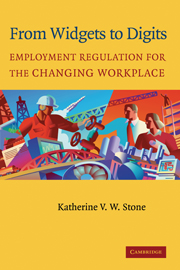Book contents
- Frontmatter
- Contents
- Preface
- Introduction
- PART I LABOR RELATIONS REGIMES OF THE PAST
- PART II THE DIGITAL WORKPLACE
- PART III IMPLICATIONS OF DIGITAL JOB STRUCTURES FOR LABOR AND EMPLOYMENT LAW
- 6 Implications of the New Workplace for Labor and Employment Regulation
- 7 Disputes over Ownership of Human Capital
- 8 The Changing Nature of Employment Discrimination
- 9 Unionism in the Boundaryless Workplace
- 10 Reimagining Employee Representation
- PART IV SOCIAL JUSTICE IN THE DIGITAL ERA
- Summary and Conclusion
- Index
10 - Reimagining Employee Representation
Published online by Cambridge University Press: 14 January 2010
- Frontmatter
- Contents
- Preface
- Introduction
- PART I LABOR RELATIONS REGIMES OF THE PAST
- PART II THE DIGITAL WORKPLACE
- PART III IMPLICATIONS OF DIGITAL JOB STRUCTURES FOR LABOR AND EMPLOYMENT LAW
- 6 Implications of the New Workplace for Labor and Employment Regulation
- 7 Disputes over Ownership of Human Capital
- 8 The Changing Nature of Employment Discrimination
- 9 Unionism in the Boundaryless Workplace
- 10 Reimagining Employee Representation
- PART IV SOCIAL JUSTICE IN THE DIGITAL ERA
- Summary and Conclusion
- Index
Summary
One hundred years ago, the eminent British labor historians Beatrice and Sydney Webb identified three goals of working-class collective action and three corresponding roles for labor organizations. They were: (1) to form mutual benefit associations, (2) to create organizations to engage in collective bargaining for job-related protection, and (3) to create organizations that could lobby for legislation favorable to employees. According to the Webbs, English unions, at different times in English history, performed each of these roles.
In the twentieth century, American unions have also played all three roles, but with a heavy emphasis on the second. Both the American Federation of Labor (AFL) and the Congress of Industrial Organizations (CIO) saw their primary function as bargaining for job-related protections. After merging in 1955, the AFL-CIO continued to emphasize collective bargaining and contract administration as the core function of unionism. Over the past fifty years, the individual national and international unions and the AFL-CIO federation have built highly sophisticated research and legal departments to provide support for their bargaining programs, while relegating their legislative, education, and organizing departments to secondary roles. As a result of these efforts, unions have been extremely effective in the collective bargaining arena. The strength of the AFL-CIO at its postwar zenith lay in its achievements at the bargaining table, one employer at a time.
In light of the transformation in the workplace, unions now need to develop new methods of operation. While there are many workers still working in the old employment relationship, evidence suggests that new workplace practices are spreading both across the corporate spectrum and throughout the employment hierarchy.
Information
- Type
- Chapter
- Information
- From Widgets to DigitsEmployment Regulation for the Changing Workplace, pp. 217 - 240Publisher: Cambridge University PressPrint publication year: 2004
